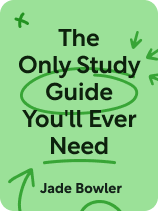

This article is an excerpt from the Shortform book guide to "The Only Study Guide You'll Ever Need" by Jade Bowler. Shortform has the world's best summaries and analyses of books you should be reading.
Like this article? Sign up for a free trial here.
What is the key to studying productively? What are the study methods that Jade Bowler swears by?
Studying is a crucial part of your academic life, so you need to know how to do it well. In The Only Study Guide You’ll Ever Need, Jade Bowler elaborates that studying effectively means maximizing productivity by getting the most work done in as little time as possible.
Continue reading to learn how to study productively with Bowler’s advice.
Understand How Your Brain Learns
Bowler explores four ideas that explain how your brain learns best and teaches you how to study productively. (She uses the acronym “SAAD” to represent these ideas.)
Idea #1: Engage Repeatedly
First, your brain remembers information best by engaging with it repeatedly over time—this popular concept is called “spaced repetition.” Bowler explains that the more time that passes after you learn something, the more information you forget. The key to overcoming this is to review the information again right before you’re about to forget it. Keep doing this each time you feel you’re close to forgetting the material. Each time you review it, you’ll be able to remember the information for longer, eventually fully ingraining it into your long-term memory.
Idea #2: Build Connections
Second, your brain remembers new information better by connecting it to concepts it already knows. (Bowler calls this “association.”) For example, imagine you have to memorize the purpose of white blood cells—to fight diseases in our body. It might be hard to remember this information alongside all the other information on an exam. However, if you’re able to connect the purpose of white blood cells to the purpose of a concept you’re already familiar with, like the mythological “white knight” who comes to someone’s aid, it’ll be easier to remember.
Idea #3: Engage Deeply
Third, your brain remembers and understands information best when it’s forced to engage deeply. (Bowler refers to this technique as “active recall.”) This is because deep engagement with information strengthens neural pathways in our brains that help us recall that information. Simply viewing study material isn’t enough to strengthen these pathways. Instead, Bowler says we need to think hard about and apply information. For example, asking yourself to define a term and use it properly in a sentence is a more effective way to remember and understand it than simply reading the word and its definition repeatedly.
Idea #4: Make It Hard
Fourth, doing things that are hard will improve your ability and understanding the most. (Bowler refers to this idea as “desired difficulty.”) Bowler explains that our brains prefer doing things that we’re good at or find easy over things that we struggle with. Doing easy things makes us feel like we’re being productive, but the brain is just tricking us into avoiding the hard work that will actually improve our abilities. So instead of spending time on easy tasks, seek out material and techniques that cause you to work harder—this is how you’ll actually increase your abilities.
Use Brain-Approved Study Methods
Bowler discusses four main study methods based on the above cognitive processes that will help you maximize your learning in as little time as possible.
Method #1: Flashcards
While flashcards are a popular method for studying, Bowler explains that they’re ineffective if not created and used correctly. For flashcards to improve your understanding, they must incorporate your brain’s preferred learning methods.
First, flashcards should require deep engagement. There are a few ways you can do this. One of the easiest ways is to create cards with a question on one side and an answer on the other—before flipping the card over, you must answer the question yourself. This will make studying with flashcards harder than simply flipping through your cards and rereading information.
Another way to encourage deep engagement is to use as many symbols as possible on your cards in place of words and phrases. Using symbols rather than words requires you to recall more information than what’s explicitly written on the card. For example, imagine you want to remember that the Rashidun Caliphate was the first caliphate and lasted the shortest amount of time, the Umayyad was second and lasted longer than the Rashidun, and the Abbasid was the last and lasted the longest. You could write “Rashidun < Umayyad < Abbasid.”
Your flashcards should help you make connections with concepts you already know—Bowler explains that using images and symbols you’re familiar with is a great way to do this. For example, to remember the order of three of the major Medieval Islamic caliphates—the Rashidun, Umayyad, and Abbasid—you could draw a picture of a radish to remind you of “Rashidun,” a picture of your friend Maya to remind you of “Umayyad,” and the name of the band Abba to remind you of “Abbasid.”
Finally, the key to boosting learning with flashcards is to study them repeatedly over time. For example, if you have a quiz in one month’s time, rather than waiting until the week before the exam and studying for 30 minutes every day, make your flashcards and start studying as soon as you find out about the exam.
Method #2: Memory Testing
Bowler explains that testing your memory and understanding is extremely helpful when studying because recalling the information requires deep engagement. Testing also allows you to gauge what you know, what you don’t know, and what you need to work on. She recommends two ways of testing your memory.
The first method involves trying to condense a concept into its most crucial components from memory alone. Then, compare what you’ve written to your full notes to see how well you understand the concept and identify anything that you forgot or misrepresented. This facilitates engagement and application. (Bowler calls this technique “summarization from memory.”)
Bowler’s second testing method involves writing down every single thing you can remember about a concept. To do this, start by writing down a few words that will remind you of the concept. Then, use those prompts to jog your memory and write down everything you can remember about the concept. Once you’re done, compare your exercise to your notes and identify what you left out—these are likely the areas you need to work on. (Bowler calls this method “blurting.”)
Method #3: Create Connections
Bowler recommends creating connections between new concepts that you’re learning and your prior knowledge through storytelling. She presents three different ways you can do so:
First, you can sort pieces of information into groups and connect each group in a logical narrative format. Bowler recommends this method because it connects the information you’re learning in a way that makes sense to you, making it easier to recall. (Bowler calls this method “chunking, chaining, and telling a story.”)
Second, you can connect elements of a concept you’re learning to elements of a routine you perform regularly—this is especially helpful for processes you have to memorize or elements that have a particular order. (Bowler calls this method “Sherlock’s mind palace.”)
Third, you can connect elements of a concept to parts of a physical object—when you look at the object, it will help you remember the elements of the concept. For example, connect the three main stages of the hydrologic cycle to your water bottle: First is evaporation—you can connect this stage to the top part of your water bottle that’s foggy because of evaporation. Next is condensation—you can connect this to the water droplets inside your bottle and imagine that they’re the product of condensation, like raindrops. Finally, connect precipitation to the water sitting at the bottom of your bottle—imagine this is the rainwater that has fallen and collected.
Method #4: Practice Taking the Exam
Finally, Bowler recommends completing past papers—real exam papers from previous years—or taking a practice exam on the subject you’re studying for. These methods provide the experience of answering the types of questions on the real exam.
Past papers are often available online or can be provided by your teacher or the exam board. If you don’t have access to past papers, create your own practice exam. To do this, look at past essay prompts, homework assignments, textbook review sections, and any revision guidelines the teacher has provided, and pick a prompt that might mimic a real exam. For example, if your exam will ask you to write a two-page essay about Macbeth in 60 minutes, choose a past essay prompt similar to a real exam question and practice writing the timed essay at home. If your exam is on the history of the Islamic empire, create an exam out of the textbook review questions for the chapters you’ll be quizzed on.

———End of Preview———
Like what you just read? Read the rest of the world's best book summary and analysis of Jade Bowler's "The Only Study Guide You'll Ever Need" at Shortform.
Here's what you'll find in our full The Only Study Guide You'll Ever Need summary:
- Why school doesn't have to be chronically overwhelming
- How students can manage their mindset, study habits, and time
- Science-backed time management and study techniques to help you ace your exams






